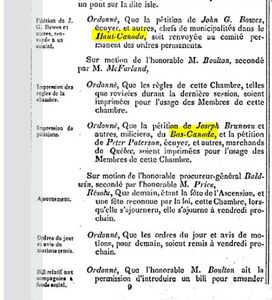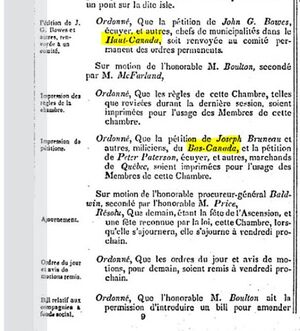- Profile
- Images
Location: [unknown]
Contents |
United Canada Uni
This page is intended to collect all the pertinent data as to whether or not the term Canada-Est should be used or not from 1841 to 1867.
The proclamation of the Act of Union of 1841 as published in the Upper Canada Gazette, Toronto, Tuesday, February 9th, 1841 makes no mention of Canada East or West at all, it just states shall form and be one Province, under the name of Province of Canada.
After the Rebellions of 1837 and 1838 in Upper and Lower Canada, the British government sent Lord Durham to study the political situation in the British North American colonies. In his report, Lord Durham recommended, in particular, that the two Canadian provinces be united to form a single province. United Canada was thus born, and consisted of Canada East (formerly Lower Canada and the precursor of modern-day Quebec) and Canada West (formerly Upper Canada and the precursor of modern-day Ontario).
The Act of Union was sanctioned on July 23, 1840, by Queen Victoria and came into effect on February 10, 1841.
The Act of Union was the main reason for the political instability that reigned in United Canada until 1867. Because the Union gave equal representation to both parts of the colony, some members of the political elite, both francophone and anglophone, were calling for rep by pop (representation by population). The situation eventually became intolerable, and led to the Great Coalition in 1864, and ultimately to Confederation in 1867.
The above is from the government of Canada pages on this subject. They introduce the terms Canada East and Canada West. Nowhere have these terms been found in legislation so far.
The Act of Union was passed by the Parliament in London on July 23, 1840, and came into force on February 10, 1841. It introduced numerous reforms. The two Canadas were to become one United Canada, with one government. This United Canada was to keep the institutions established by the Constitutional Act of 1791: a governor who was answerable to the British Parliament, an executive council appointed by the Crown, a legislative council of 24 members, appointed for life, and a house of assembly of 84 members, half to be elected by Canada East and the other half by Canada West . Officially, Canada East and Canada West simply replaced the names Lower Canada and Upper Canada. In practice, however, the former names did not die quickly.
The implementation of political union, which unified the economy as well, greatly pleased the Canadian business class. However, it only made the French Canadians angry, for several clauses of the constitution humiliated them. For example, Canada East, which had a larger population than Canada West, was allotted the same number of elected representatives -- a breach of the principle of democracy. The civil list was raised to 75,000 pounds per year, and elected members no longer had any control over it. Also, section 41 of the Act of Union decreed that English was to be the only official language of the country. This was the first time that England had prohibited French in a constitutional text.
The objective pursued by England in the Act of Union was clear: hammer together a British-style parliamentary system with an artificial majority, while waiting for immigration to run its course and give the British a real majority. Such a system would in all likelihood adopt policies favourable to British colonization. So it was that French Canadians began their existence as a minority.
The measures of 1841 created deep wounds. In the Québec City region, petitions called for the abolition of the Act. Some people suggested withdrawal from political life. The reaction was so intense that, in 1848, London had to recognize and accept the use of French.
For administrative purposes, the new Province was subdivided into Canada West and Canada East. The former name of "Lower Canada" came back into official use in 1849.
1841 to 1849
From 1841 to 1843, the terms Canada East and Canada West were used. The former names of the two colonies, Lower Canada and Upper Canada, had no constitutional status. Quebec act divided Canada into two parts, Canada east and Canada west.
1849 to 1867
From April 25, 1849, the Canadian Parliament enacted an interpretation act, which once again gave legal meaning to the terms Lower Canada and Upper Canada:
- The words "Lower Canada," shall mean all that part of this Province [that is, the United Province of Canada] which formerly constituted the Province of Lower Canada.
- The words "Upper Canada," shall mean all that part of this Province which formerly constituted the Province of Upper Canada
- Wikipedia: Canada East citing Statutes of Canada, 12 Vict., c. 10, s. V. In counterpart is also found: « that part of this Province formerly constituting the Province of Upper Canada », « the late Province of Upper Canada » ou « that part of this Province which was formerly comprised within the limits of Upper Canada »
Use of Lower Canada post-1841: (samples)
- Lower Canada Agricultural Society, incorporated by act of the Provincial Parliament, July, 1847 (page 5 for actual document)
- By-laws, rules and regulations of the College of Physicians and Surgeons of Lower Canada 1848 (page 5 for actual document)
Archives du Québec
A query was sent to provincial library and archives (BAnQ), since a former item in the provincial governement website was no longer to be found. Here is the question and answer received (in French).
Summary translation: I asked for the legal status of the term Canada-est between 1841 and 1867, since a former page on the government of Québec's site had disappeared. The answer gives first a more complete publication of the statute that created The Province of Canada than the English version found (#1 above and below). There is no mention of Canada Est/Ouest at all in there. Just Province du Canada.
They go on to show that the expressions Canada-Est/Ouest appear soon after 1841, A), but that concurrently Bas-Canada/Haut-Canada continue to be used B) in various newspapers etc. C) shows official journals of the Legislative Assembly, images are from 1850-1851, and show that either terminology is used concurrently. Secondary sources cited in D) show the terms Haut and Bas-Canada, Province du Canada, and Province du Canada-Uni. (notations are to their catalog, since Archives are also the main library for the province).
They conclude with the point that Canada-Est/Ouest, while they don't appear to have legal status, are in use from 1841.
Question
Bonjour,
Je cherche à connaître le statut légal du terme Canada-Est entre 1841 et 1867. Autrefois le gouvernement du Québec avait une page à ce sujet, qui disait que Canada-Est n'avait aucun statut légal selon eux. Page maintenant introuvable sur leur site. Vous pourriez éclairer ma lanterne svp? Merci de votre attention.
Danielle Liard
Réponse / answer
Bonjour Danielle Liard,
Nous avons effectué des recherches afin de vous aider à trouver réponse à votre question.
Afin de connaître le nom officiel qui désigne le territoire de la province du Canada entre 1841 et 1867, nous vous renvoyons à l’Acte pour réunir les provinces du Haut et du Bas Canada, et pour le Gouvernement du Canada, que l’on appelle aussi l’« Acte d’Union ».
En vertu de ce texte officiel, les provinces du Haut et du Bas Canada constituent dorénavant une seule et même province désignée sous le nom de « Province du Canada »
Exemples / Samples
- A) Les expressions Canada-est et Canada-ouest, bien que non officielles, apparaissent assez tôt dans les documents d’époque. Par exemple, nous avons effectué une recherche dans les journaux numérisés de 1841 à 1867. Vous pouvez consulter en suivant le lien suivant les mentions dans les journaux d’époque :
Recherche de journaux: Canada-Ouest
- B) Toutefois, les expressions « Haut-Canada » et « Bas-Canada » sont toujours employées bien après l’union. Vous pouvez consulter les mentions dans les journaux numérisés en suivant ce lien :
Recherche de journaux: Haut-Canada
- C) Aussi, dans les journaux de l’Assemblée législative du Canada, le nom officiel pour désigner le territoire est également « Province du Canada ».
Or, nous retrouvons des mentions de Canada-Ouest, ainsi que Haut et Bas Canada dans les journaux de l’Assemblée législative du Canada. Voici deux exemples tirés de l’année 1851.

|
| Canada-Est Versus Bas-Canada Image 1 |

|
| Canada-Est Versus Bas-Canada Image 2 |
- D) Dans les sources secondaires, il est tantôt question du Haut et du Bas-Canada, de la Province du Canada, de la Province du Canada-Uni. Nous avons retrouvé ces expressions dans les documents consultés suivants :
Histoire générale du Canada
Auteur : Brown, Robert Craig, 1935- , éd. [21]
Publication : [Montréal] : Éditions du Boréal, [1990] (Louiseville : Impr. Gagné) [501]
Description : 694 p. : ill., cartes, portr. ; 19 cm
Type de document : Livres imprimés
https://cap.banq.qc.ca/notice?id=p%3A%3Ausmarcdef_0000108021&locale=fr
Histoire populaire du Québec
Auteur : Lacoursière, Jacques, 1932- auteur [145]
Publication : Québec (Québec) : Septentrion, [2013]- [2053]
Description : 1 ressource en ligne (volumes) : illustrations
Localisation électronique et accès : Accès par PRETNUMERIQUE.CA (format ePub) : vol. 1, Accès par PRETNUMERIQUE.CA (format ePub) : vol. 2, Accès par PRETNUMERIQUE.CA (format PDF) : vol. 2, Accès par PRETNUMERIQUE.CA (format ePub) : vol. 3, https://banq.pretnumerique.ca/accueil/isbn/9782896648634
https://cap.banq.qc.ca/notice?id=p%3A%3Ausmarcdef_0006269630&locale=fr
Bref, bien que les expressions « Canada-est » et « Canada-ouest » ne semblent pas avoir de statut légal, elles sont employées dès 1841 dans les documents d’époque.
En espérant le tout à votre convenance,
Équipe de la Bibliothèque nationale Recherche et diffusion des collections patrimoniales
- BAnQ: Bibliothèque et Archives nationales du Québec/Québec National Library and Archives http://www.banq.qc.ca/accueil/
- Login to edit this profile and add images.
- Private Messages: Send a private message to the Profile Manager. (Best when privacy is an issue.)
- Public Comments: Login to post. (Best for messages specifically directed to those editing this profile. Limit 20 per day.)

